CAPTAIN JUDY HELMEY
“Kicking Fish Tail Since 1956”
POB 30771
SAVANNAH, GEORGIA 31410
912 897 4921 912 897 3460 FAX
Captain Judy’s email fishjudy2@aol.com
November 2023 Captain Judy monthly inshore offshore fishing report and Rescue at Sea story! Dates for 2024 fishing schools!
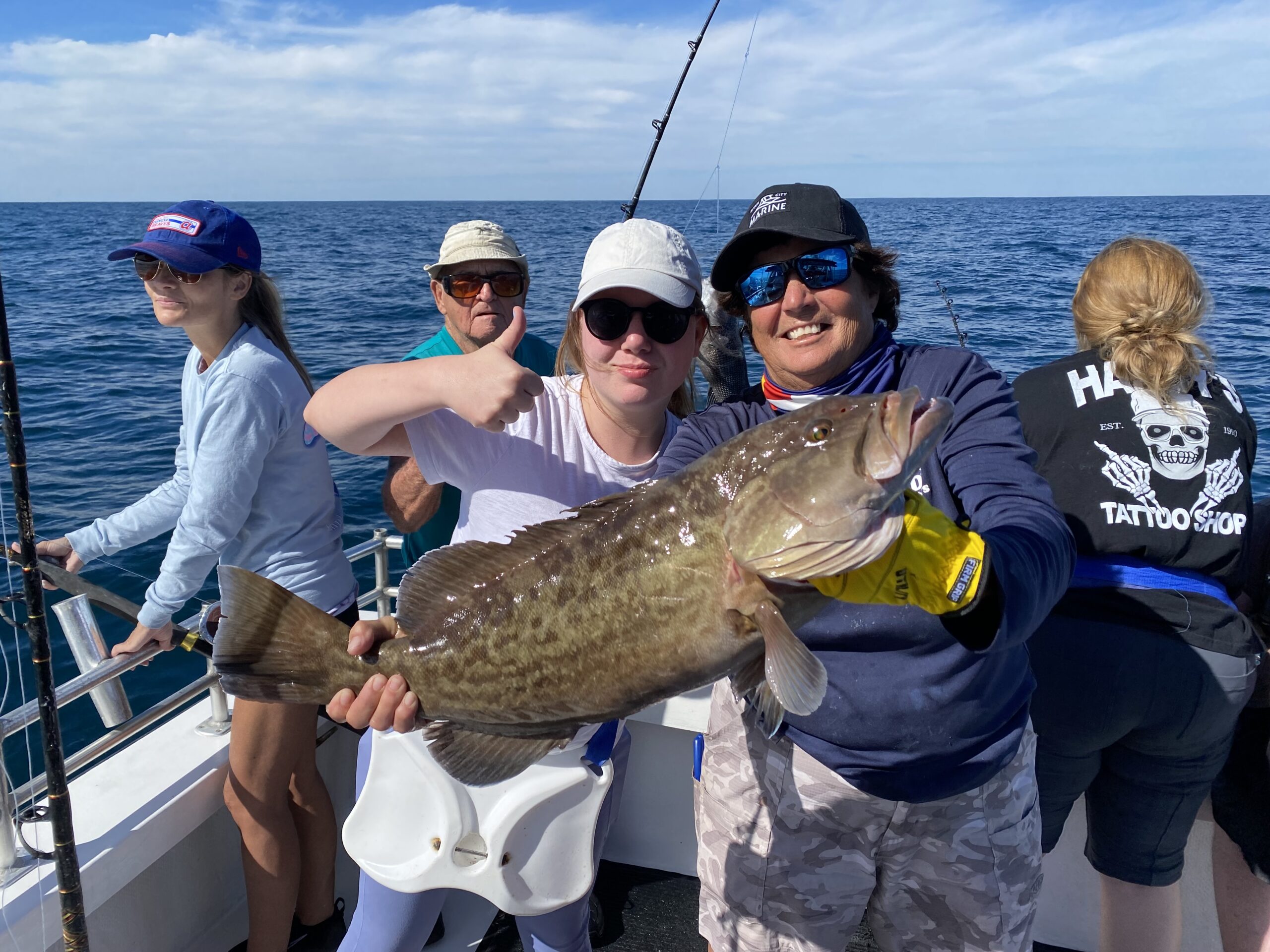
Although gag grouper season closed this year on October 23, 2023 until May 1, 2024 we managed to slip this one in. This fish, as you can see from the marks on its side, was basically pulled out of its ledge. This gag is an unusually dark color for being caught at the snapper banks. Normally they are much lighter in color. So therefore, this gag must have been in and around the ledge for quite a few days. It had already adapted the coloring of the dark inside of its cave/ledge. Anyhow, you can catch them you just can’t keep them!
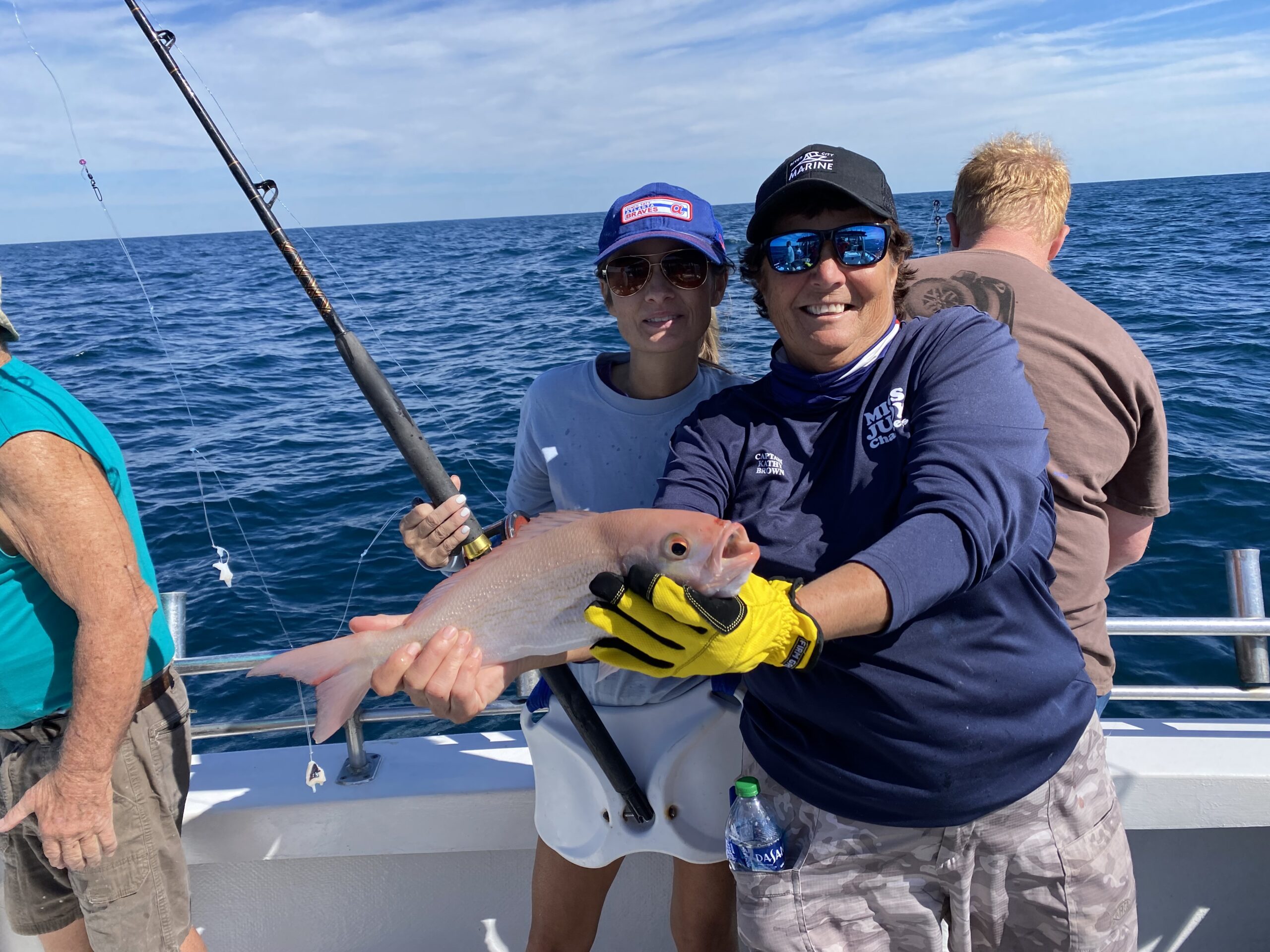
Captain Kathy Brown is holding a nice vermilion snapper also known as a b-liner. It is a popular fish that is in the snapper grouper family, which boils down to the fact that they certainly do taste good! The size vermilion is also called a football!
2024 Captain Judy’s Inshore/Offshore Fishing Clinics
February 16, 2024 Friday, February 17, 2024 Saturday and February 18, 2024 Sunday
Inshore/offshore boats in the water
$200.00 per person for inshore
$200.00 per person for offshore
Morning departures
Time: 8:00AM till12:00 NOON
Place: Miss Judy Charters dock
202 Wilmington Island Road, Savannah, Georgia 31410
912 897 4921 for more details!
We offer classes on the water in the boats! Sign up soon!
(Miss Judy Charters 912 897 4921or email me fishjudy2@aol.com)
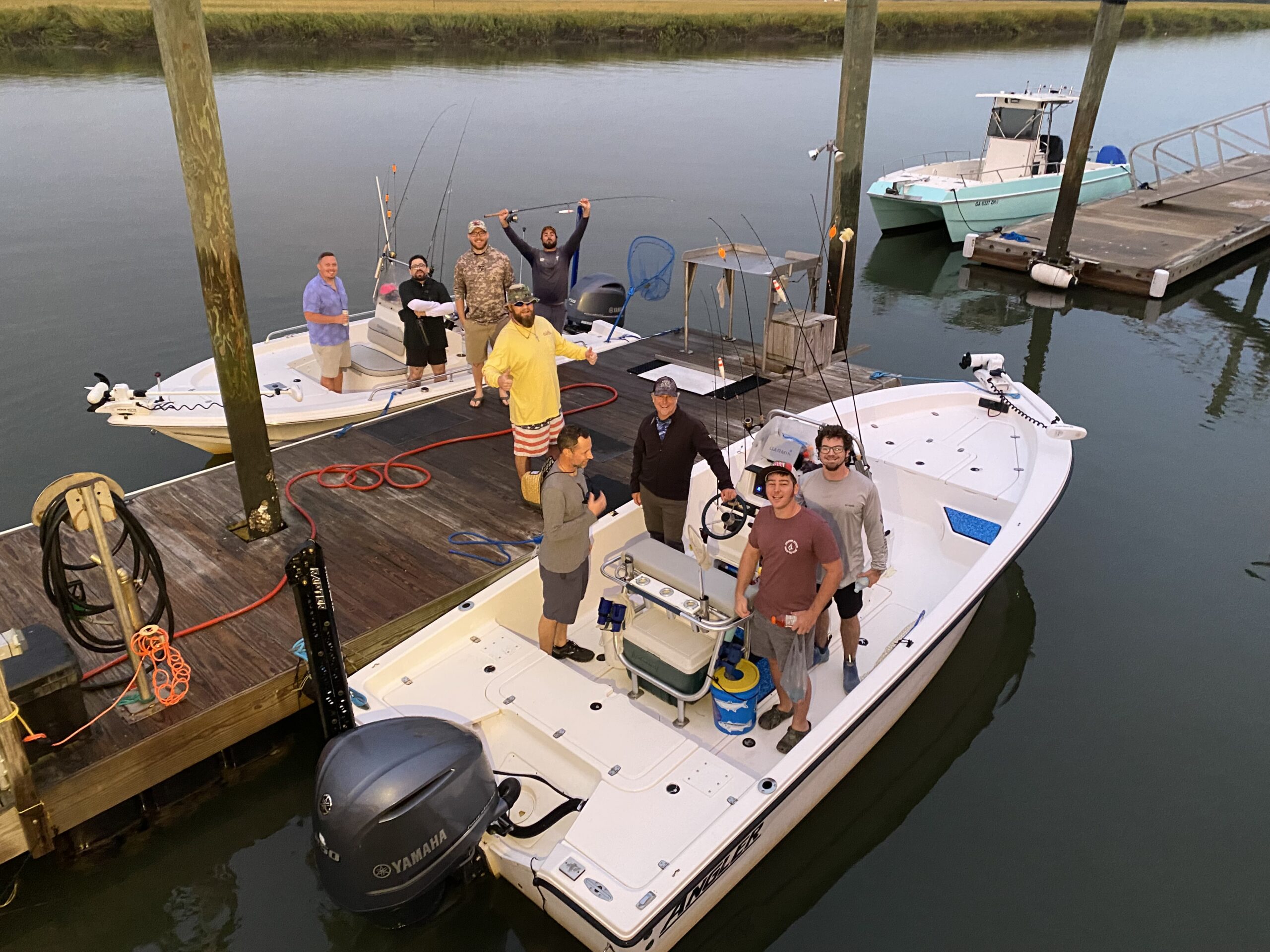
What do we have here? 7 happy soon to be catching fishers and two happy inshore fishing captains!
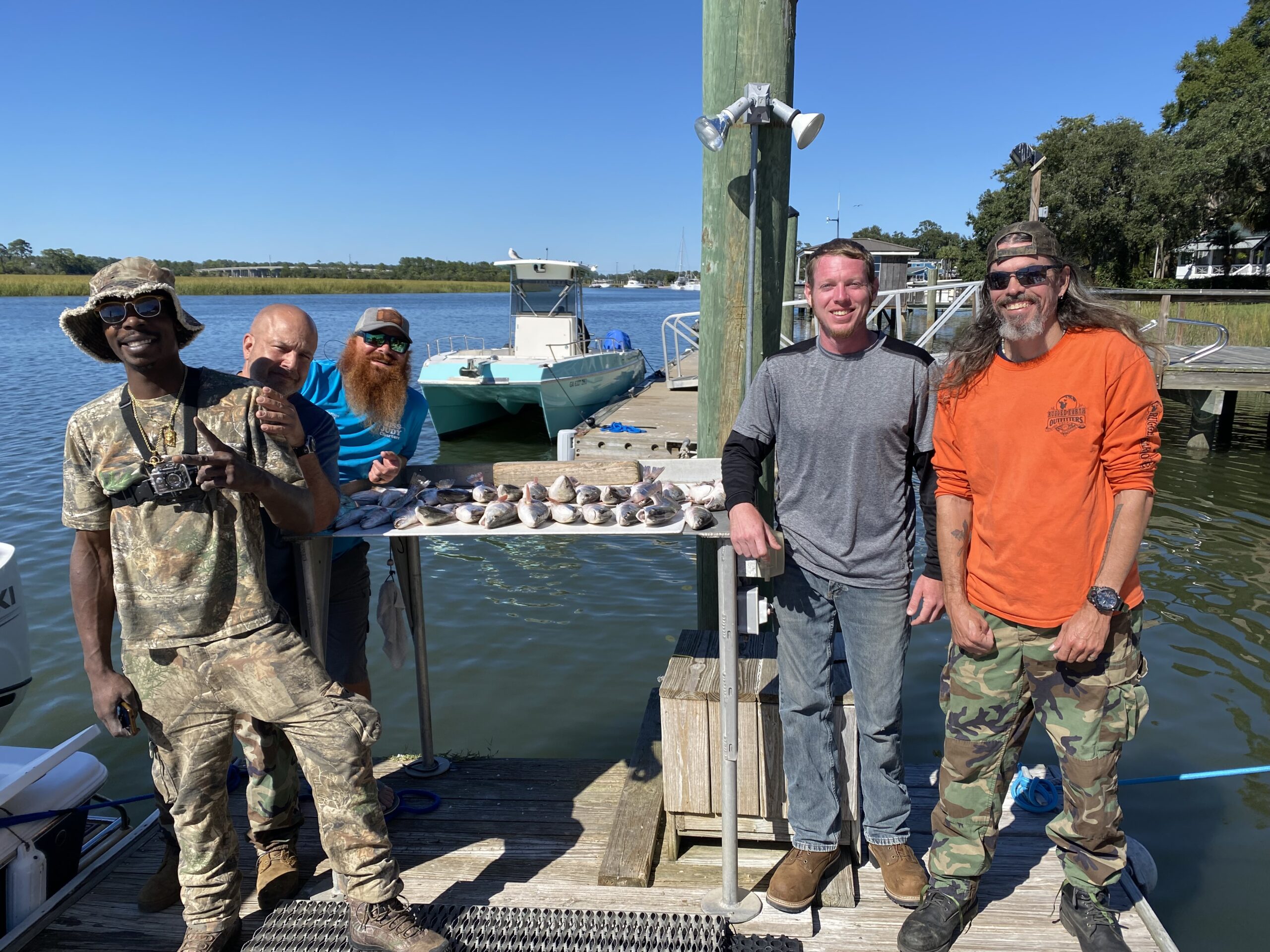
Captain Jake Ross of Miss Judy Charters, his customers, and the mess of fish that his fishers caught! Nice catch!
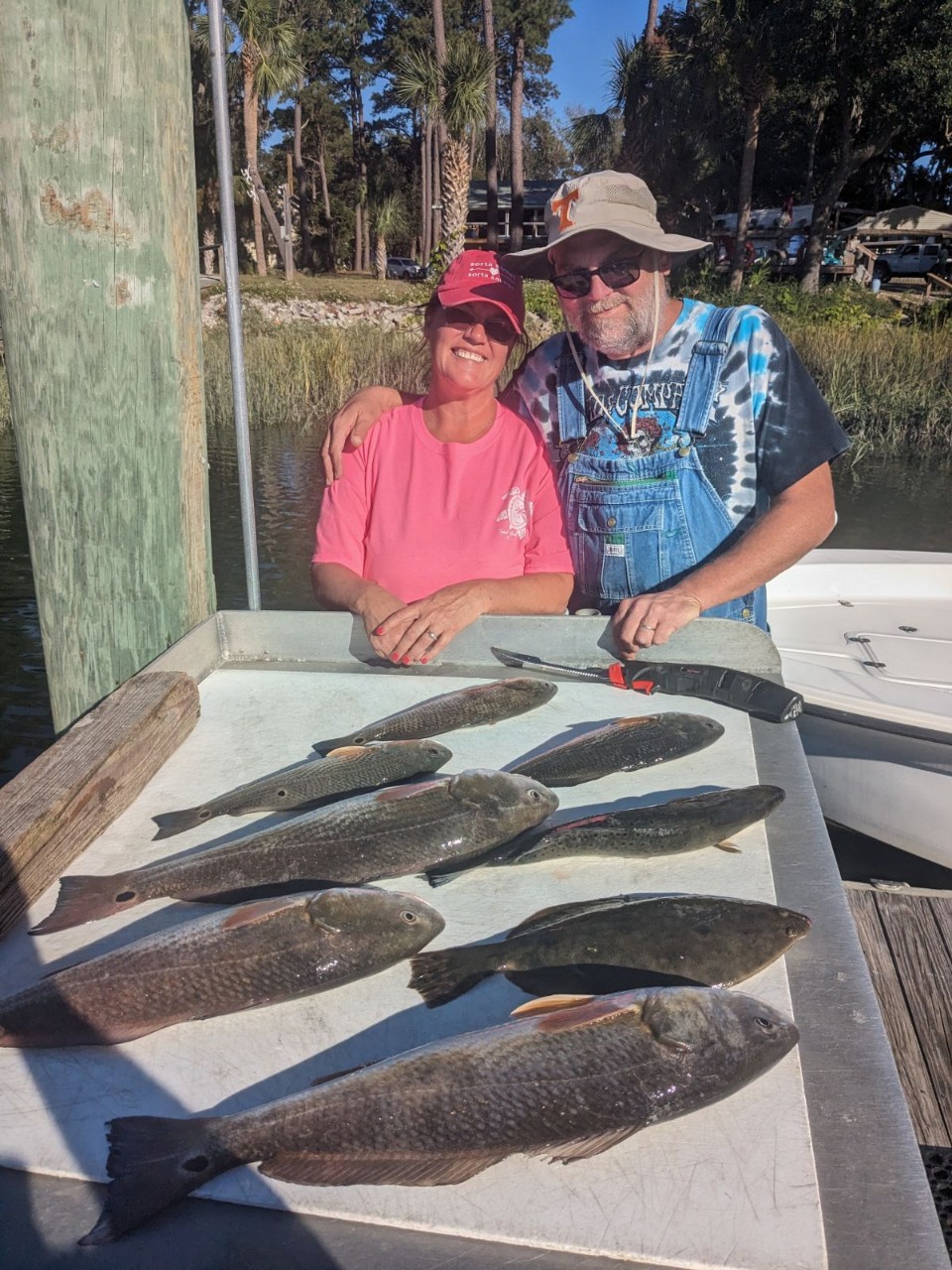
These two fishers do pretty darn good! I know that caught these and I saw the pictures of the ones they released! Who showed them the way? Captain Justin Rahn of Miss Judy Charters
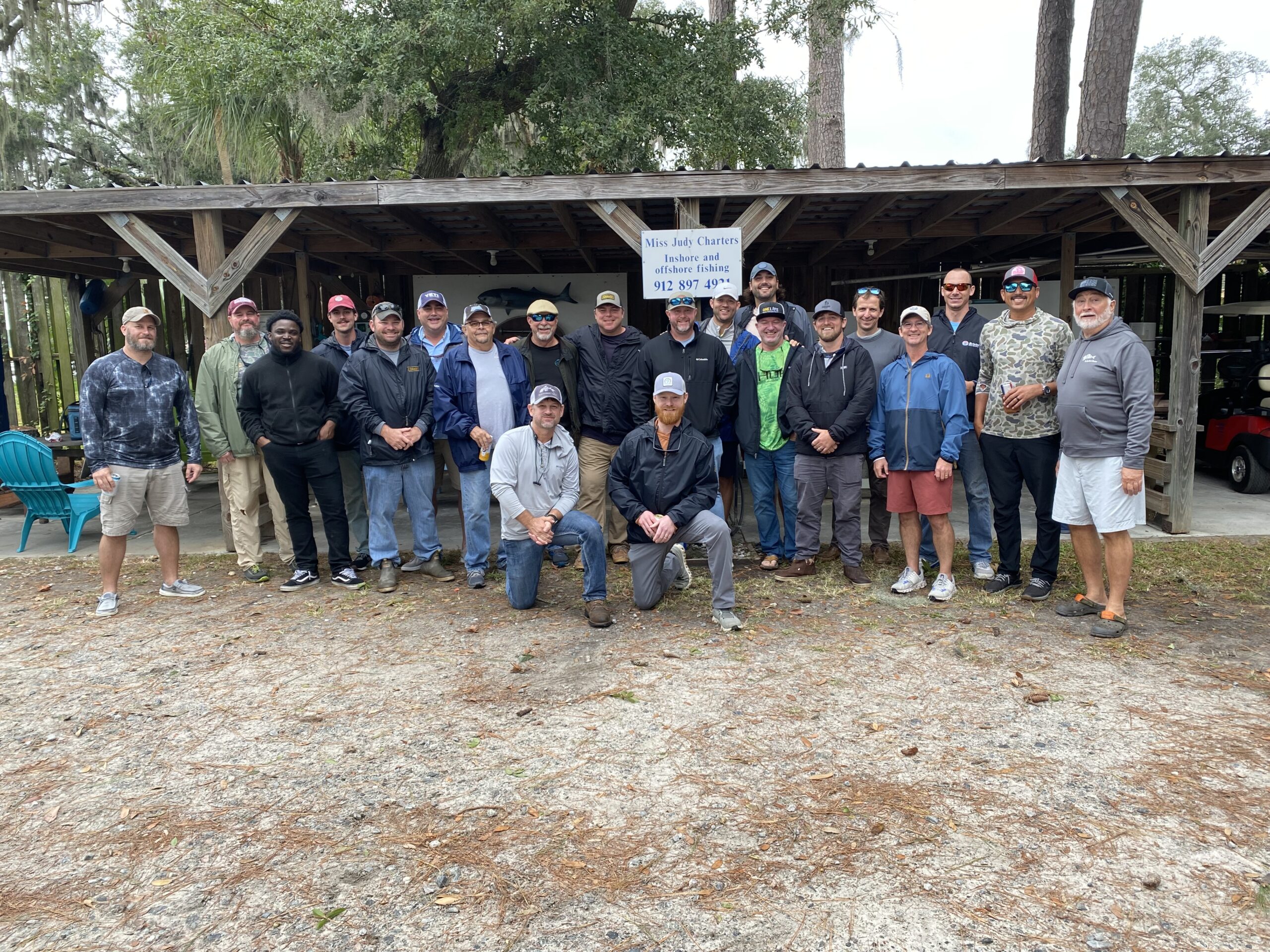
Robbie Stewart and his Fine Inshore Choate Fishing Team! And these fishers can fish too! They did very good! As far as inshore fishing for red fish, spotted sea trout, flounder, etc the bite goes on until the end of December. Then, when January rolls around red fish are still on the hunt as well as the solid bite that they deliver!
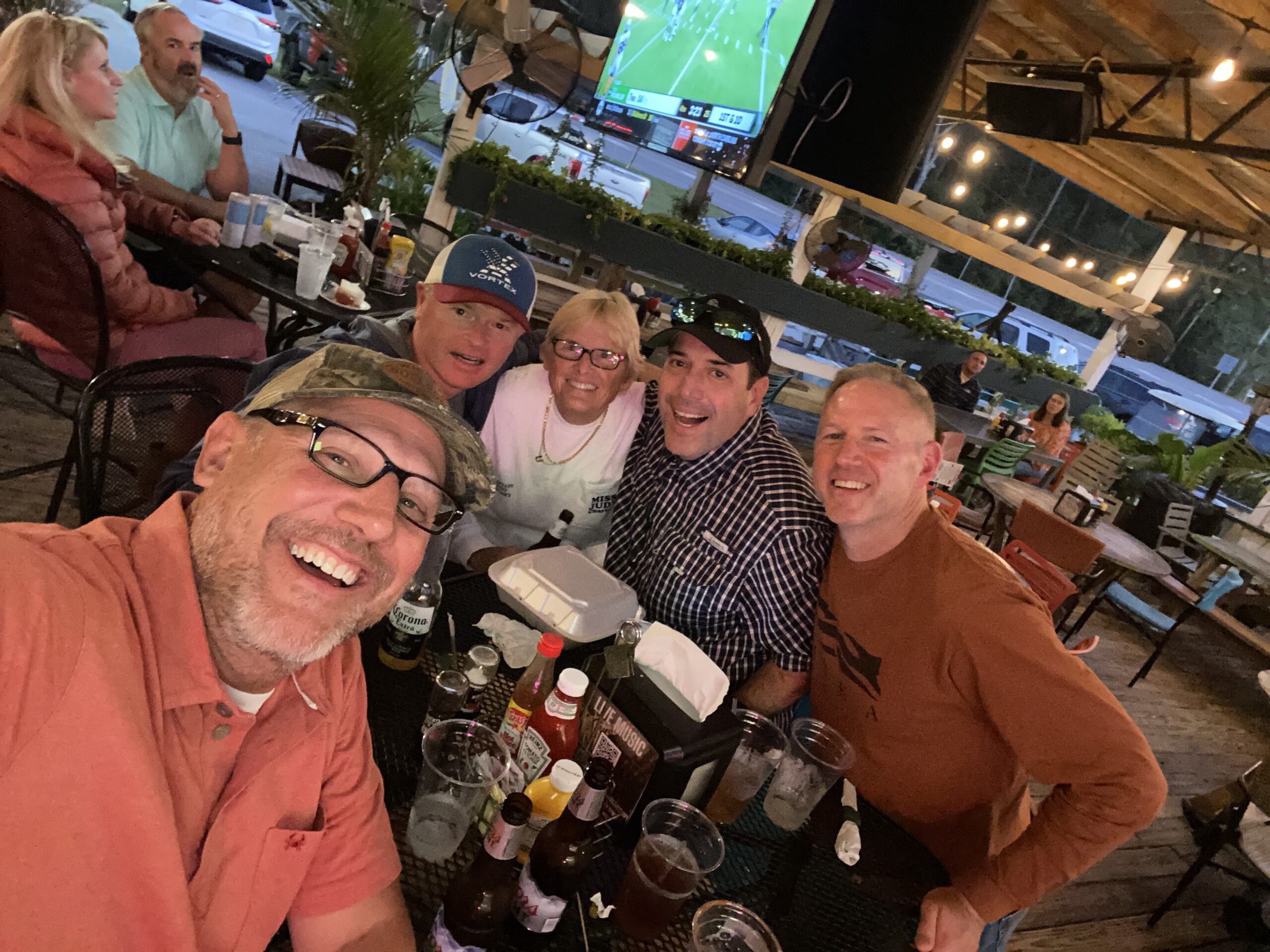
Most all of our customers take some of their fish to be cooked over to the Flying Fish Bar and Grill, Savannah,
Georgia….heck after all where can you get fried, grilled, or blackened fresh just caught fish, 2 sides, hushpuppies, and the making for less than 12 bucks? Nowhere that I know of! Heck, I suggest going whether you fished with us or not! The food is great!
Inshore report
When the month of November rolls around the inshore bite certainly does pick up. It is much easier to score a Savannah Slam, which is red fish, spotted sea trout, and flounder. The secret to catching more inshore fish during this time is to use live shrimp as bait. All fish like shrimp, because it’s easy to eat, easy to kill, and it’s more plentiful. And it seems that once you get the bite “a going” it’s simple enough to change straight to any sort of artificial shrimp pattern. As far as how to present your live shrimp there are several ways: Popping corks with 3 to 4 foot leaders. It’s best to put a shot weight about 1 foot above the hook, because this helps keep the bait deep under the cork. Another thing good about popping corks is the sound that they make when they are popped. They sound just like a shrimp flapping its tail up against its body! This is a spotted sea trout, flounder, and red fish “head turner” for sure. Traditional adjustable floats come in all sizes and work great when trying to find the bite at different depths. When anchoring is the plan, I suggest using the larger versions of the traditional adjustable corks, because it enables you to make longer drifts. The larger corks can be seen for a further distance allowing you to be able to cover a lot more area without changing locations. This is a very good tip especially when fishing in a cooler water situation, because “fish beware” sounds seem to travel further. It seems the more you move the longer you have to wait to see if there really is any sort of bite in the area picked to fish. For those fishermen that want to use artificial only this is the month for you. The secret when going this route is to use lighter tackle for that better feel. I like using 8-pound test monofilament line while tying artificial bait directly meaning no leader needed. Here are a few artificial suggestions: DOA’s rigged or not, Berkeley scented gulps, Strike King soft baits flukes, paddle tails, and etc. My favorite cold water colors are electric chicken, baby bass, and root beer. (And let’s not forget Candy Corn!) Finally there is “Just fishing naked!” All you need is hook, leader, and bait….shrimp swims where it thinks it safe and that’s just about where the fish are in waiting!
Another great inshore bait during this time of the year is finger mullet, which are very hardy. What does this mean? You just might be able to catch a couple of fish on one bait. The only other bait that I know that fits into this category is the poor misunderstood mud minnow, which definitely is the hardiest of the two.
The inshore big bull trophy reds population was strong in October and the month of November is normally even better. These big fish love to school around anything that offers them a source of food. Deepest side of a creek or river mouth is going to be the best place to anchor. The best bait for getting this fish’s attention is going to be a standard beef up Carolina rig and cut fish for bait. When making this rig I suggest using a shorter leader than you normally do. This application keeps you bait close to the bottom, which is where the old red fish is looking to find its next meal.
Back in the old days we used finger mullet and steaks cut from larger ones for bait. I suggest cutting your mullet into steaks and letting it air/sun dry out. In other words, do not put it back in the cooler. As the bait dries it seals in the fish calling stinking juices that only a mullet has to offer. Once introduced back into the water the sealed in scents disperse. It worked then and it works now!
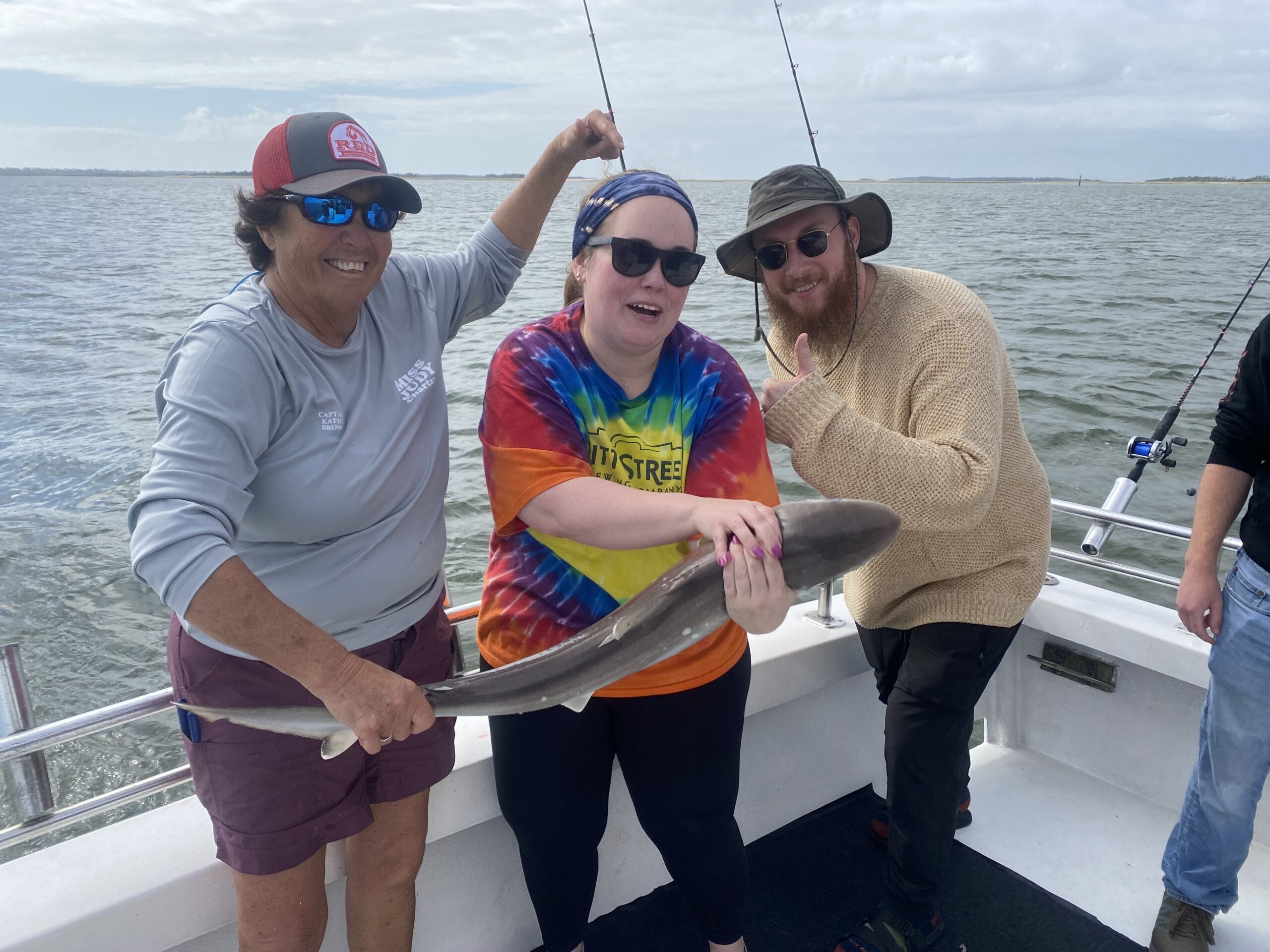
Atlantic Sharpnose Shark
November is a great month to do a little sound fishing! Why? Well, there is a pretty good shark bite to be had in our area. We hold the attentions of quite a few different kinds. (Just to name a few: bonnethead, Atlantic sharp nose, black tip, hammerhead, etc..) Whiting, blue fish, summer trout, as well as other biters pick up. The whiting also known as southern kingfish are great fish when fried. These are the prefect size fish to just gut, take their heads off, scale, and fry them whole fish. You cook them like a freshwater fish that you have caught in saltwater!
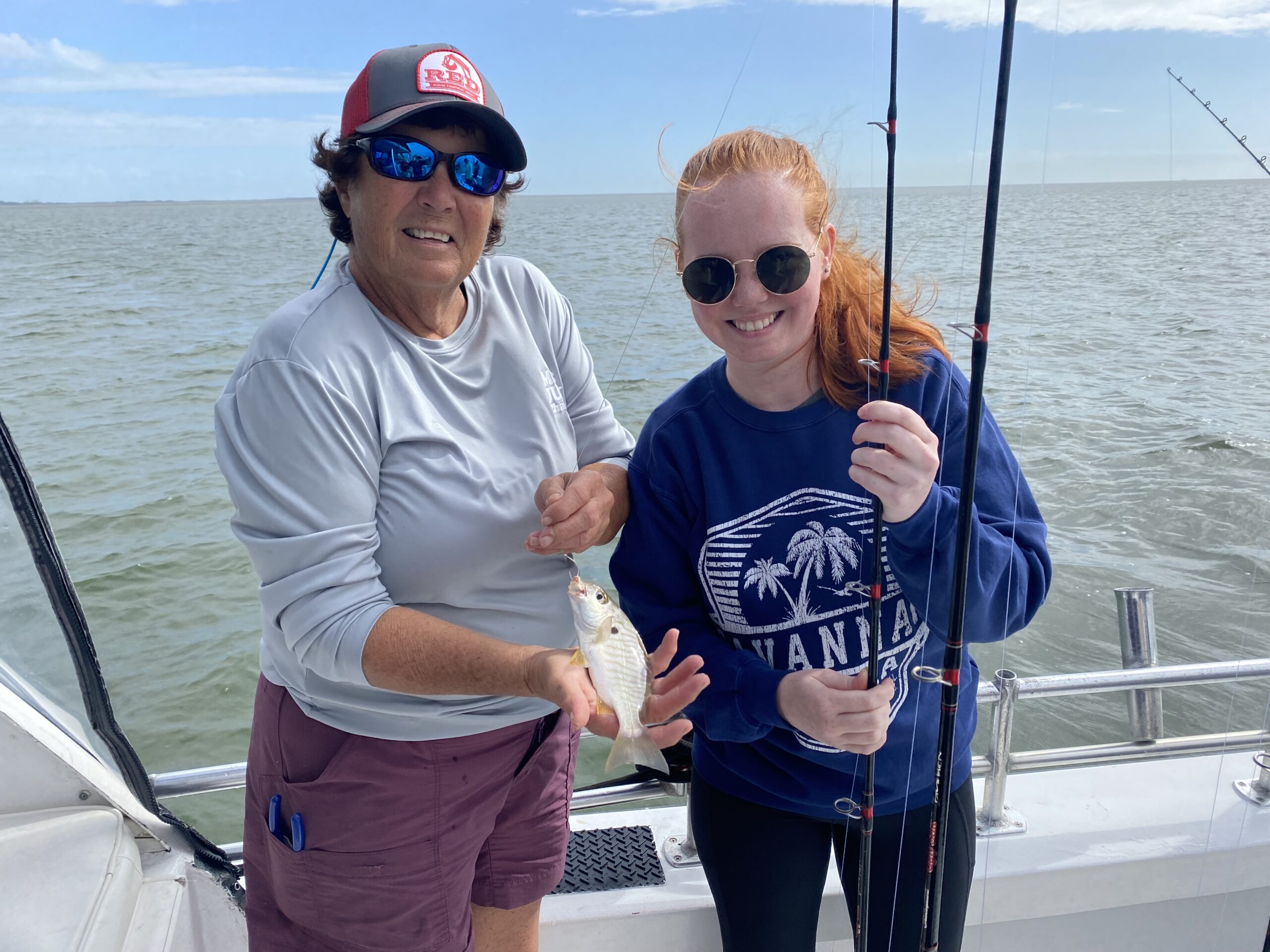
Captain Kathy Brown is holding a nice size spot, which gladly hits a small piece of peeled shrimp! Did we release or use it as bait? The fish is still making way in other words, “Just a swimming!”
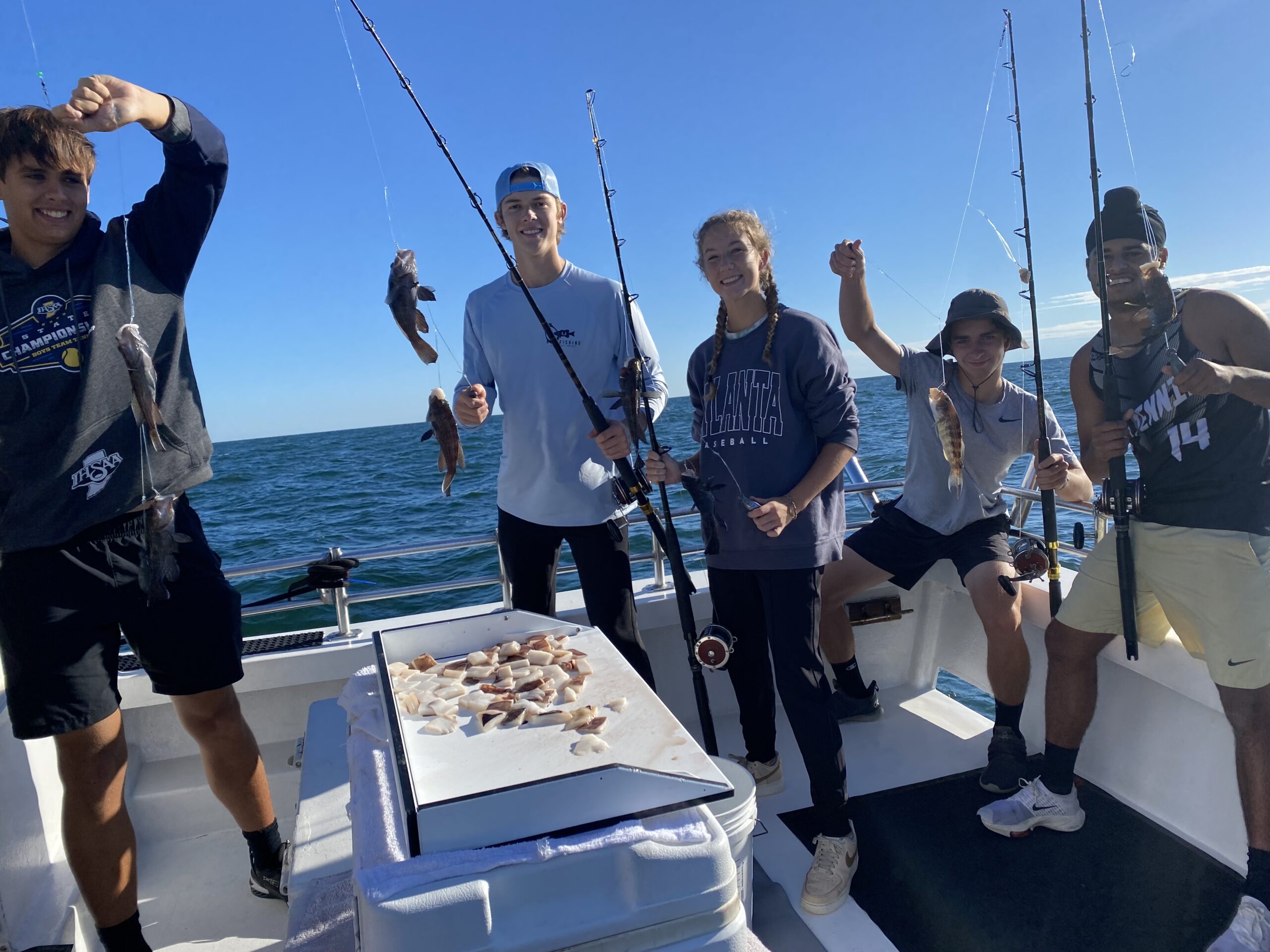
During the months of October, November, and December the nearshore artificial reef bottom fishing is great. What the heck does this mean? Well, bait your hook, drop it to the bottom catch a fish, reel it in, take fish off, if not legal-size release, if legal-size you keep, and repeat for as many times as your arm will allow. This fine fishing group during a 3 hours of bottom fishing time caught and released a little over 200 fish. They kept 10 nice sea bass, which equates to 20 fillets or 40 half fillets, or provides just enough meat for a serious mess of fish tacos!
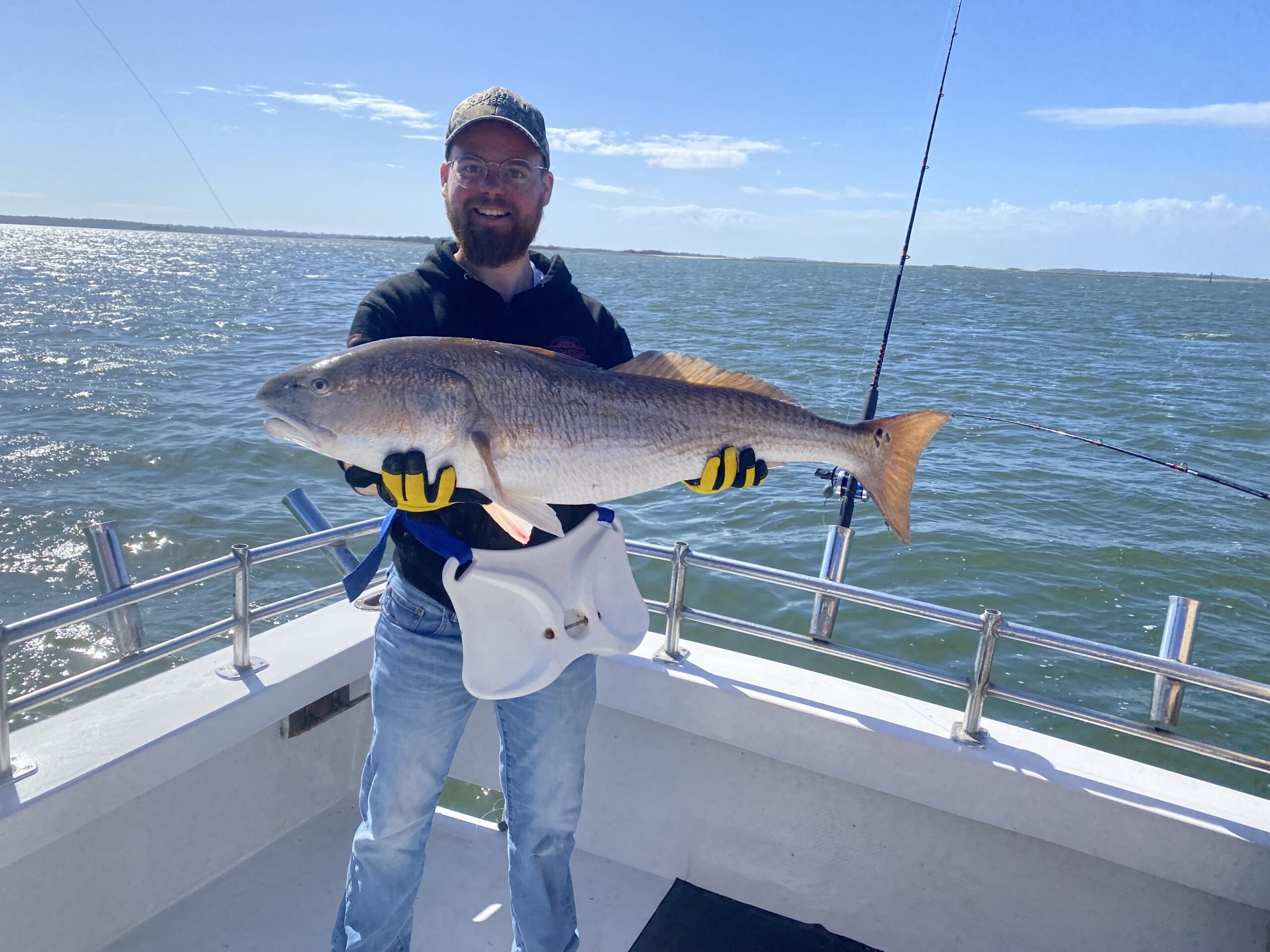
It’s Trophy Red Fish Time!
The boys or maybe the girls have come to town! During November the water temps are great for holding the attention of trophy red fish such as the one shown above. Now you can’t keep them, but you can catch, take a picture, and then release. All red fish over 23 inches are not legal to keep when caught in state waters. All size red fish caught in federal waters must be released. If you go with us (Miss Judy Charters) you don’t have to worry about the regulations. We try to stay up to date! However, if you’re fishing on your own, please get up front and personal with current fishing regulations! Why? The game warden is always watching!
The trophy red fish during this time loves to fill up anything that will fit in its mouth. And after doing so around the sound area they push offshore to areas where more feeding potential can be found. And after many years of hearing fishers talk about the whims of all sizes of red fish I, Captain Judy, after more years than I want to admit, have come up with what I think is pretty good red fish feeding reasoning.
Captain Judy’s Red Fish Feeding Reasoning!
And it goes something like this…..All red fish love to eat the contents of what comes wrapped in a shell. This belief is backed up by the incredible crushing teeth located in the red fish’s mouth. It is my opinion, that when a red fish sucks in any type of crab, mussel, oyster, snail, or anything that comes wrapped in a shell, it is crushed up. Once crushed up the meat part goes down the gullet and the shattered shell parts are pushed right out the gills. And this is as simple as it comes for sure.
However, over the many years it has come to my attention that in some cases even though the red fish still wants to eat, it cannot. As the temps drop, bait fish (the softer food) move on or basically go into hibernation mode. The red fish depends more on food that comes wrapped in a shell. And sometimes the red fish must grab its intended meal quicker due to constant pressure of other fish feeding also. So, the process of sucking in, crushing, and separating the meat from the shell is changed up a bit. In other words, steps are left out. What? The crushing of the outer shell never takes place, and it gets sent directly to the gullet. In my opinion, what happens then? Red fish’s gut is full to the brim with meat that is wrapped in an outer shell covering. And it takes two to three days for the red fish’s digestive system to melt away the shell covering. And this my fishing friends is my reasoning why red fish especially during the colder months fed so erratically!
Offshore
Artificial Reef report
The bottom fishing at the artificial reefs located in 50 to 70 feet of water normally are holding a nice buildup of black sea bass. Just about all structures on the reefs will hold fish. However, sometimes you must look before you find the bulk of the bottom fish. The best bait is going to be squid and cut fish. Artificial Reefs such L, CCA, and J buoy normally are holding the attentions of the winter end run of the Spanish/king mackerel. The chances are normally strong during this month for mackerel activity. We normally pull 2 ½ to 31/2 Drone Spoons for the kings and small to medium Clark spoons for the Spanish mackerel. Best trolling speed is 5 to 7 knots. For those fishermen that want to drift these areas with light tackle and live baits this is a good time to go this route. I would like to report as of the October monthly report the Spanish/king mackerel bit has been pretty much non-existence. Now, as you fishers all know this can change for sure!
Trophy red fish could also be caught while trolling, bottom fishing, or live lining these areas. Please remember these fish are on the federally protected program list. You can catch them, but you can’t keep them! Please handle this fish with care and release it as soon as possible!
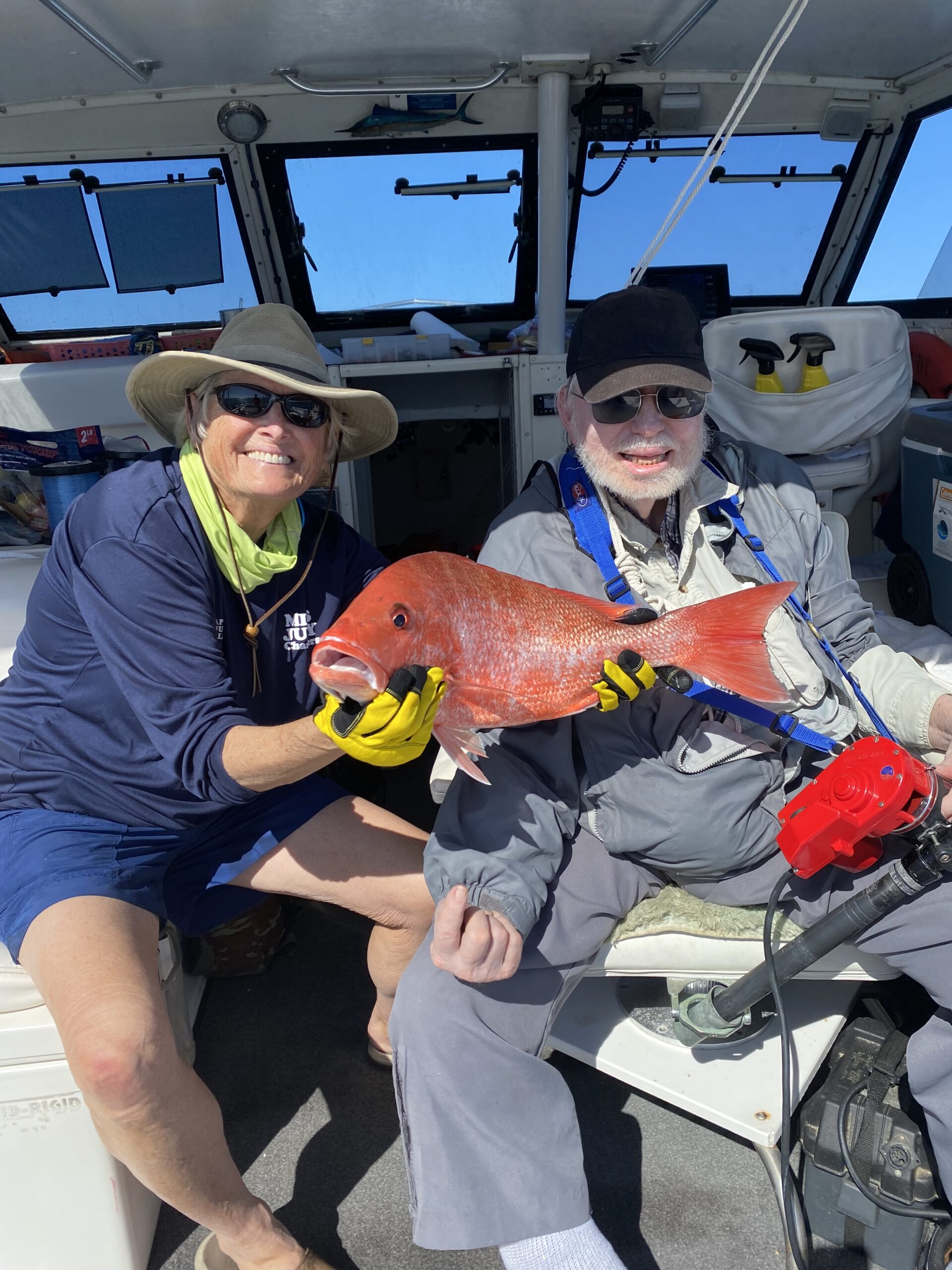
Captain Judy Helmey is holding up a nice genuine red snapper that David Miller caught while doing a little bottom fishing. Since red snapper season is no longer open this fish was quickly vented properly and sent back to the bottom to join its other 50,000 fin friends! Am I kidding, NO I AM NOT! At one time during this fish day, I stopped at a ledge in about 110 feet of water, we dropped, and both fishers hooked up. David and Christopher both caught fought and released genuine red snapper in the 18-pound range.
And here’s the darndest thing, which wasn’t normal, but now is for sure. A school of the same size genuine red snapper followed the hooked fish to the surface. The next hook up was accomplished by just dropping the bait over the gunnel. And could I see the fish take the bait? Yes, that is how close they were to the surface.
Our Genuine Red Snapper Dilemma!
There is no denying, at least in our area, that the so-called depleted red snapper stocks are no longer. I would say, “Based on what I am seeing, at least in our live bottom areas off Savannah, Georgia, that the stocks have really rebounded!” And if you are a fisherman that fish’s this area you already know that I know that you know!
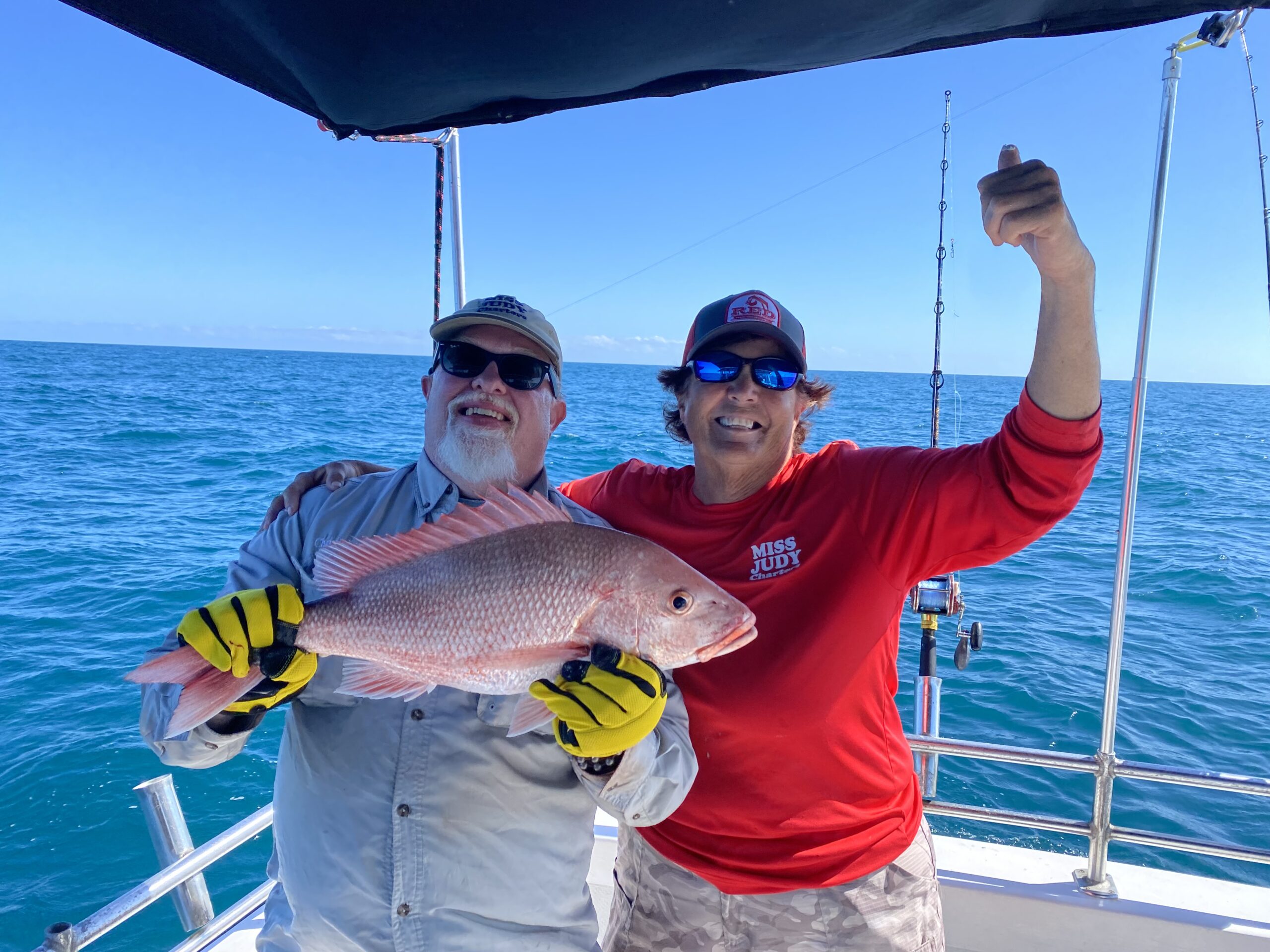
Christopher Miller and Captain Kathy Brown are for sure sporting genuine red snapper smiles! Christopher is holding one of many genuine red snappers that he caught fought and released!
Savannah Snapper Banks report
Bottom Fishing at the Snapper Banks
Bottom fishing at the Savannah Snapper Banks
By the time you get to read this report Gag grouper will have closed on October 23, 2023 and will open on May 1, 2024! Also red porgy sometimes referred to as Charleston snapper was closed on July 1, 2023 and will open on May 1, 2024. I always suggest checking for any up-to-date changes in the fishery regulations. Go to safmc.net/regulations/ for the latest federal fishery details. I also suggest keeping up with the state fish regulations. It can get very confusing especially when the game warden says, “Nope, that fishery is closed!” And all along, because you didn’t check, you thought it was open!
Now if you want to talk to a live person about the regulations, please give call Kim Iverson Public Information Officer for
South Atlantic Fishery Management Council 843-571-4366 or Toll Free 866-SAFMC-10 (Kim’s up to date with all regulations, very helpful and easy to talk too.) My suggestion is that you always know before you go!
So, let’s talk about what you can target while fishing the Savannah Snapper banks.
In the big bottom fish department, red grouper and scamp grouper (also known as broomtail) Both fish need to be 20 plus inches to keep.
Best live baits when targeting grouper are small vermilion, pinfish, sand perch, bluefish and rock bass. If you can’t catch these baits while plain old bottom fishing with squid, give the old sabiki rig a try. Here’s a list of other catchers and keepers…cubera snapper, white grunt, flounder, amberjack, almaco jack, banded rudder fish, white bone porgy, knobbed porgy, trigger fish, black sea bass, vermilion snapper, and other large mouth hungry biters. For those that like the standard old bottom fishing with live bait such as cigar minnows or Spanish sardines or cut squid now is the time. Best rigs to use to catch these live baits are going to be Sabiki gold hook rigs. Whatever you do always carry extra bait rigs, because they work great and get a lot of abuse. We have been catching baits in rips and over any sort of structure. The best news is during these times it is easier to find the bait because it normally is schooled in the upper water column near the structure. Now for those that don’t want to mess with catching bait I suggest picking up a box of frozen cigar minnows or Spanish sardines at your local bait shop. You will notice that the Cigar minnows will be more expensive than the Spanish sardines. I suggest purchasing the Spanish sardines and keeping them frozen as long as you can. These partially frozen baits whole or cut in half will stay on the hook better. If you can’t find any frozen baits I suggest putting the old cast net in the boat, because we still got lots of menhaden. This bait will work live and when cut up. While making way through the rivers, sounds, and beachfront you could find yourself in menhaden catching heaven. When this bait fish is schooling near the surface some will flip indicating their exact location. I suggest giving them a catching try. Sometimes all it takes is one cast to fill your live well. The small menhaden whether they are dead or alive work great and you don’t have to cut them up. If you do catch a lot of them I suggest not over filling your live well. When there are leftovers, I suggest putting them in a bucket and cover with salt water. This type of soaking will help keep their shine alive. The shine is what makes them dine!
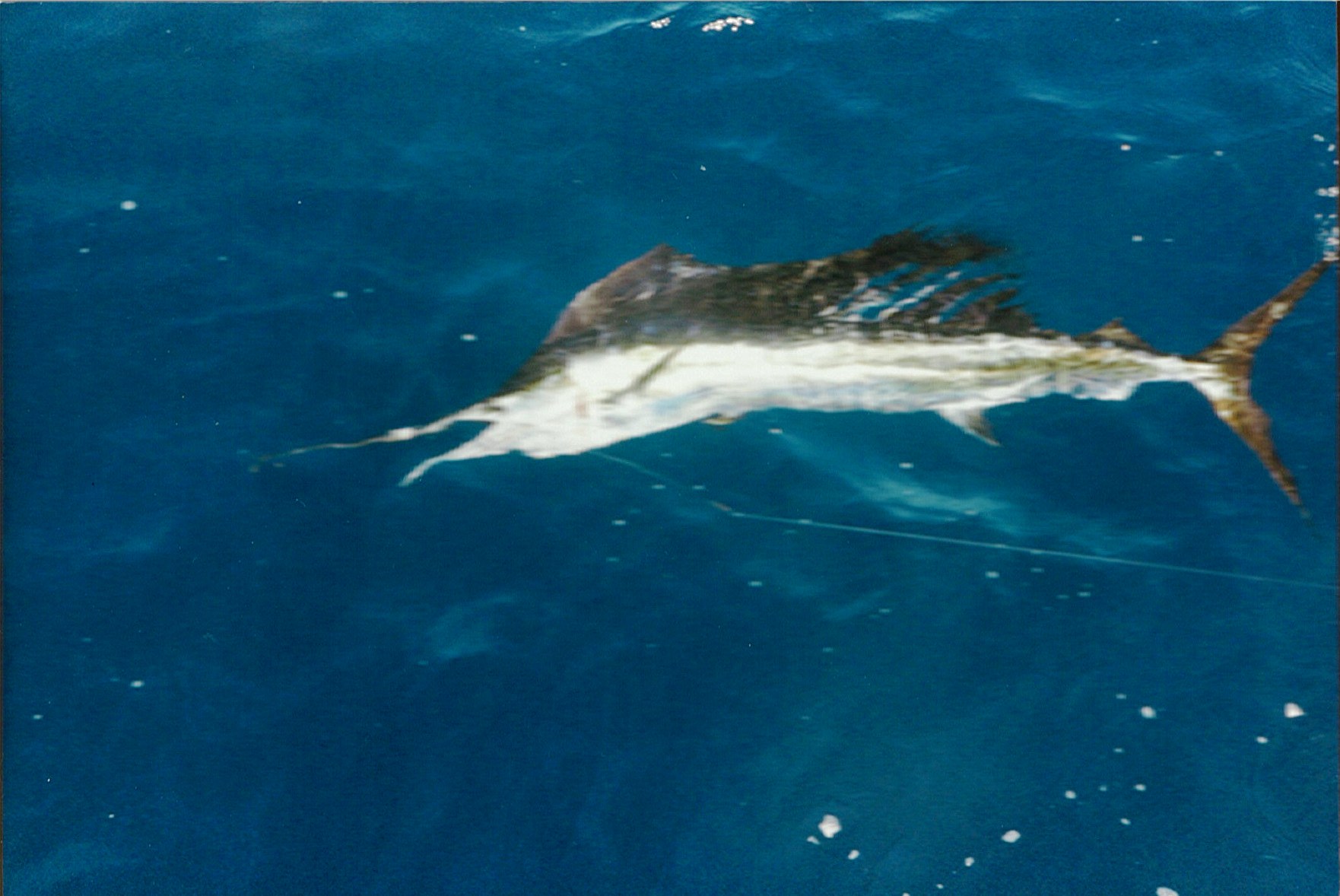
sorry this pic is very blurry…it is old and was taken using film! and re-copied by me!
Gulf Stream report
Trolling and strolling the blue water express!
A nice sail fish making a pass! From yesteryear’s old blue water picture album, which were taking while using film. I do believe that this was the sailfish that Dr. Kornblatt caught in the mid-nineties!
For those fishermen that don’t mind a longer ocean ride the blue waters of the gulf can certainly hold the interest of big game fish especially during the month of November. During this time the edge between the cooler western waters and the continuously northern pushed warmer waters of the stream is formed. This is where smaller fish feel safe and where larger fish feed. As far as best baits to drag, you certainly do have lots of options. For those fishermen that want to do a little rigging I suggest dragging ballyhoo from small dinks to large horse size dressed in different color skirts or rigged just plain naked with or without chin weights. For those fishermen that just want to drag the artificial stuff, believe me it does work. I like pulling cedar plugs that have been soaked in menhaden oil. This is where you forget the painted cedar plugs and just go plain cedar. Or do a little sanding/scraping on the painted ones so as to expose the wood. This wood can really soak up the oil and when trolled it leaves a nice oily “happy” trails.
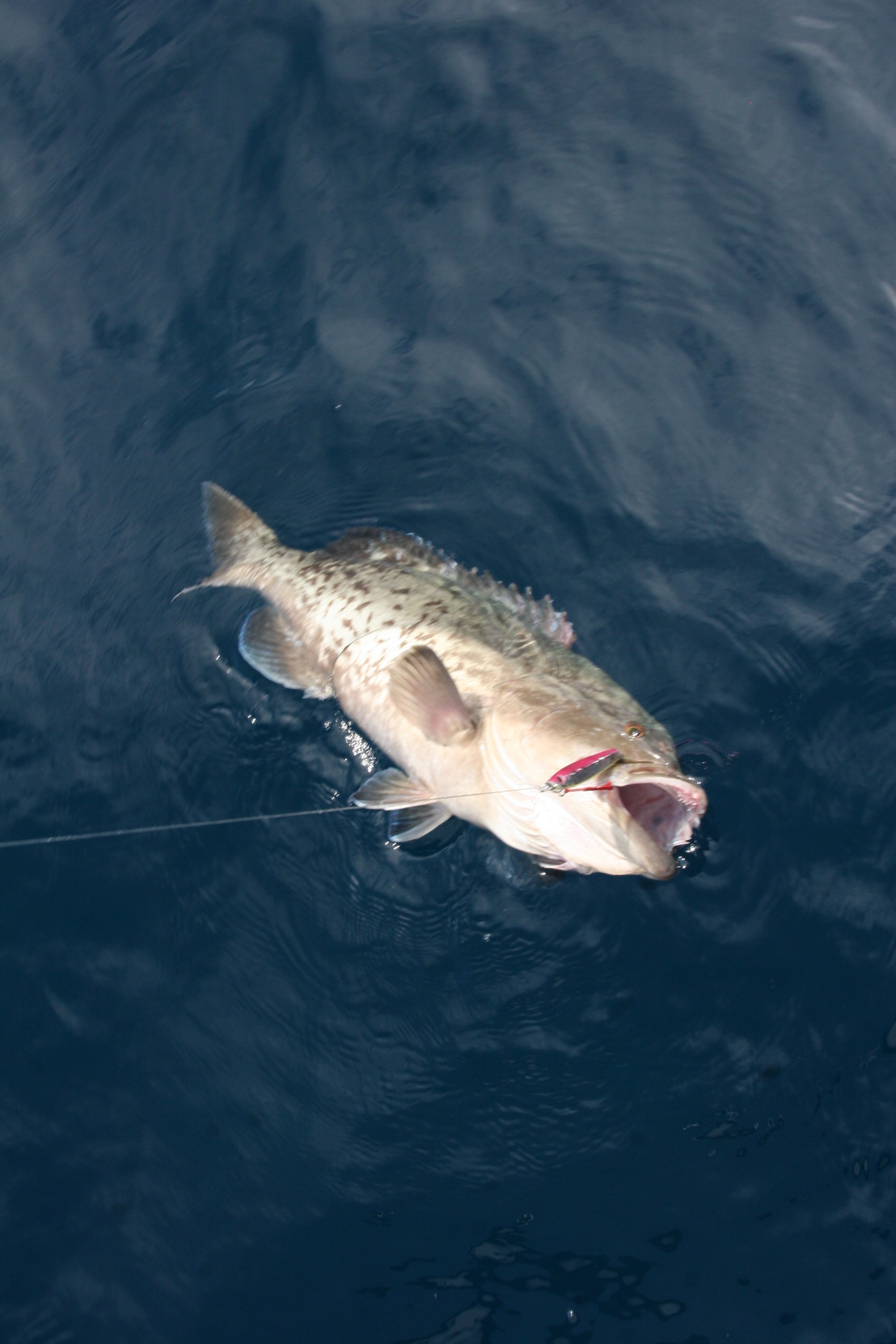
Captain Steve “Triple Trouble” Howell caught this very nice gag grouper while jigging!
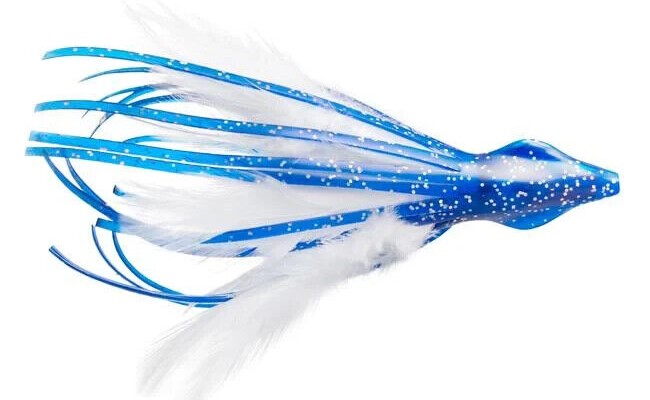
Dolphin Delight Lure
It is the best, the easiest to use, fish love it, the most inexpensive, and the most forgotten!
My favorite blue water lure of all time! Why? It works! Why? Fish can’t pass it without trying to eat it! The Dolphin Delight lure comes in different colors. My preference is the one shown above. When I set my trolling spread behind the Miss Judy Too BLUE WAS THE COLOR I USE! Why? It worked the best for keeping me hooked up! However, it might not work for you! So therefore, don’t give up trying using different colors. This is the simplest lure on the market. You can rig for a single hook or you can rig for three hooks in a row. I suggest when fishing blue water to use single hook and when in green water I suggest 3 hook rig, then rig ballyhoo accordingly!
And this lure will also work when rigged with a single hook no bait needed. It works being pulled behind any sort of bird or just trolled on the surface! And after 59 years of fishing under my belt I should know for sure!
Dolphin Delight made by “No Alibi” is a plastic squid lure made with feathers and it works great when pulled about 4 feet behind any sort of bird. Best lures to pull are old school black/silver and blue/silvers Halcos. Back in the old days we pulled a black with orange bottom lure that was called Terminator and for good reason. YO-ZOURI bonitos lures are great big game trolling baits and they have the new update version of my old school bait. And if the trolling doesn’t work, there is always deep water jigging for big gags and scamp grouper. Best jigs for deep water are the big boys Williamson lures (my favorite Bethos speed jig) or SHIMANO jigs (flat sides 7 to 10.5 ounce) All you have to do is to drop these jigs on the ledge, keep them close to the bottom, and work them. Big bites will happen! I suggest jigging with a medium drag and you had better keep a strong grip on that rod! Thanks for reading! Captain Judy
(Miss Judy Charters 912 897 4921or email me fishjudy2@aol.com)
“Little Miss Judy’s Believe It or Not!”
Captain Ken Kennickell encounters with the “stealth bomber without wings.”
Navy Seals Adventure! And really happened!
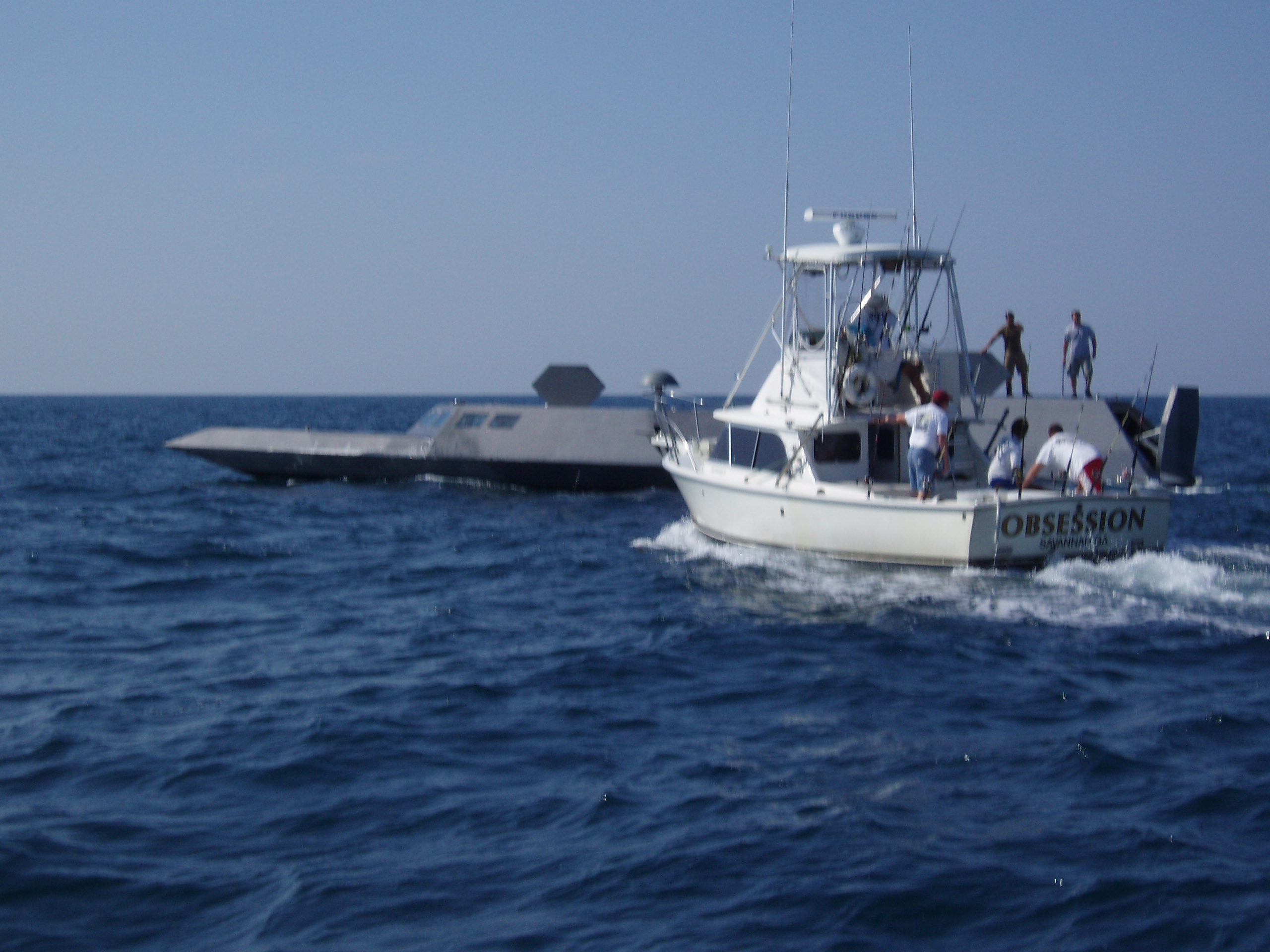
This happened in 2007 and its finally time to share this story with you!
Captain Ken Kennickell “Obsession” along side the Jet looking boat without wings!
Captain Ken Kennickell “Obsession” of Miss Judy Charters had quite a fishing/scary story to share with us during the summer of 2007. On this day the ocean was flat calm at the Savannah Snapper banks. Captain Ken and his first mate Cole had a fishing party of 3 on board. All the customers wanted to do was to catch some nice size fish. So, Captain Ken’s first morning stop would be the old amberjack/grouper hole. (61224.9/45366.0 Captain Judy’s loran coordinates) It didn’t take very long before the first two fishermen had fought and caught their big fish. The third fisherman was quietly sitting on the cooler waiting for his turn. As Captain Ken was standing next to the cooler the third fisherman lean against him. At that moment Captain Ken looked down he watched as the fisherman gave way and fell to the deck.
On impact the fisherman went into a seizure alone with biting his tongue. Blood was pouring from the victim’s mouth in what seemed like minutes, but it was only seconds before all onboard tried to assist him. The bottom line to this situation is to get help as soon as possible while keeping the victim as comfortable as you can. All of this while worrying about whether they were doing or not doing the right thing. After all none of us are even close to being in the medical field.
After quickly making way to the helm Captain Ken picked the radio up, he wondered at the same time would anyone answer. His boat was situated about 45 miles from any landfall. Our Ship to shore radios are good, but sometimes there are reasons that they don’t get out too well! At any rate he made the call for assistance. He hailed the Coast Guard Station Tybee on channel 16, paused, listened, and went to key the mike again. And Coast Guard station Jacksonville answered, and Captain Ken explained his situation and requested a helicopter. Coast Guard Station Jacksonville requested their coordinates. As Captain Ken went to key the mike a voice came over the radio. It said, “this is the vessel, so and so!” Captain Ken didn’t catch the name! Then the vessel with the goggle name replied, “We will be happy to assist we have we have several medics on board!” Captain Ken answered quickly with a big “yes and thank you!” His next transmission was, “Where are you located?” Radio man answered, “We are less than 4 miles away!”
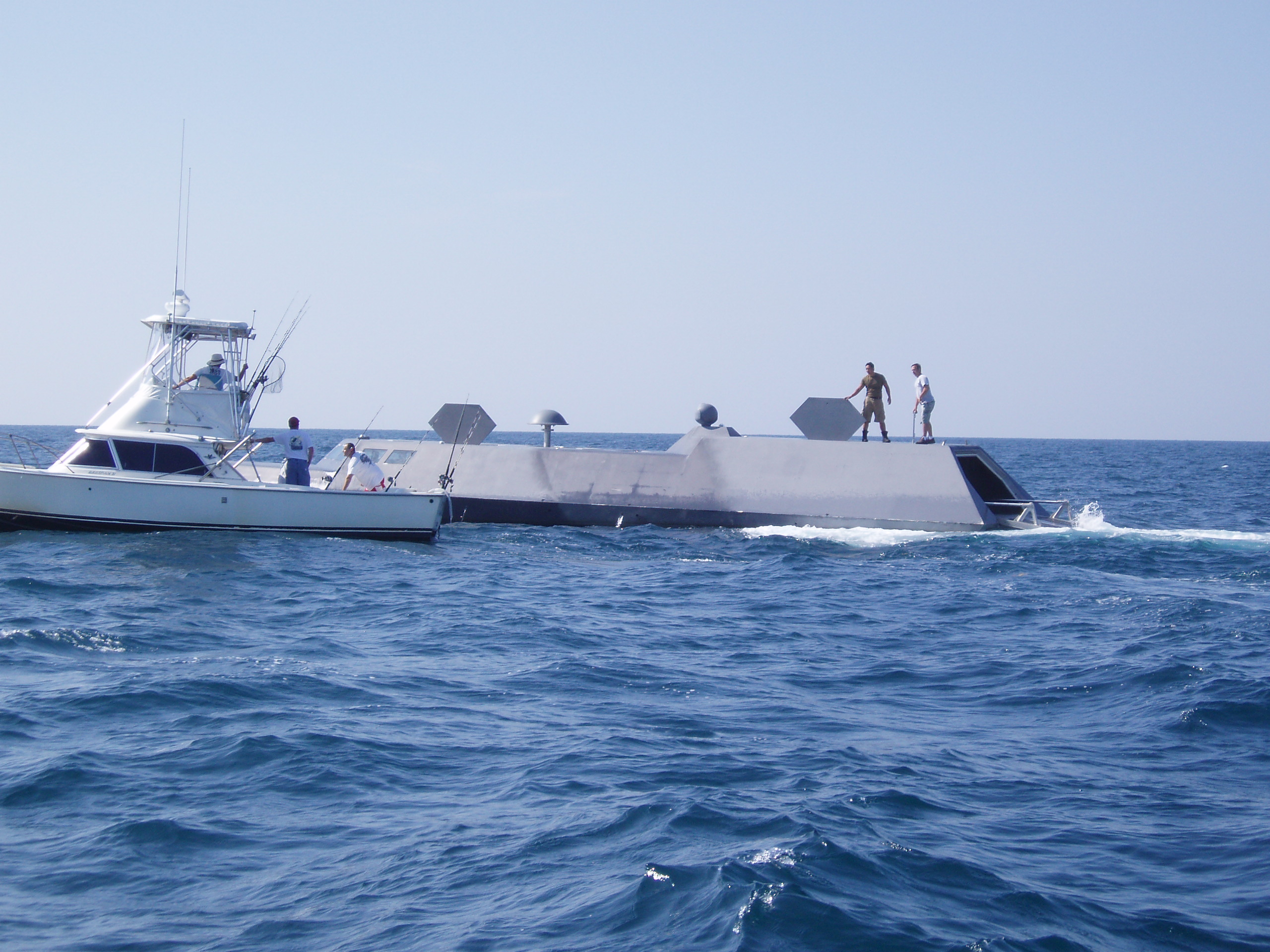
The back hatch was opened, and a small, manned rubber boat was deployed!
Now I was not on the boat with Captain Ken, but I can guarantee that he was looking over his shoulder as I would have. All along wondering where’s the vessel that this transmission was being sent from.
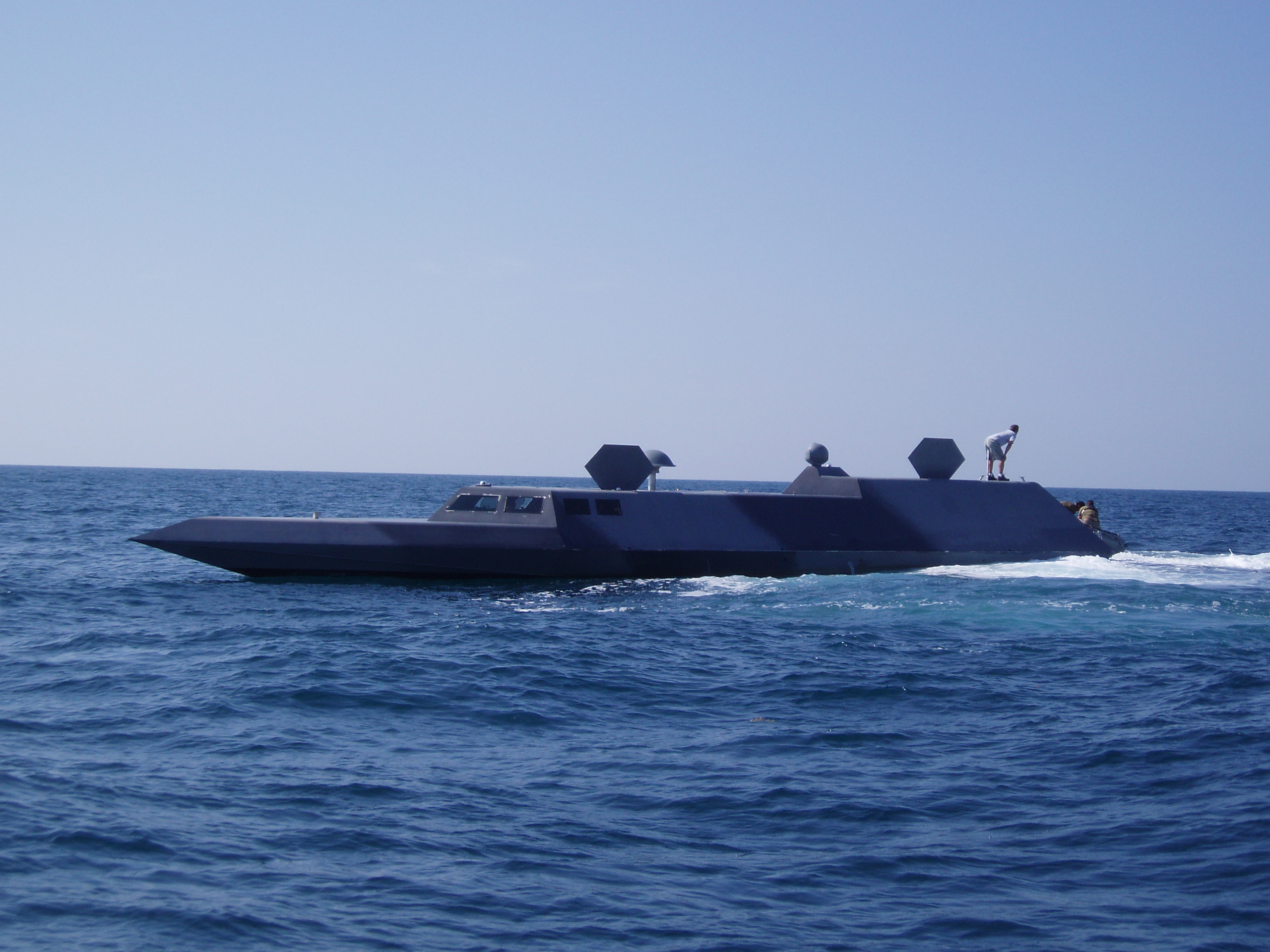
Small rubber manned boat being quickly.
deployed!
As they talked the vessel came hard and fast from the east at a high rate of speed. It was a strange looking vessel. According to Captain Ken it looked like a big jet ski! It was riding low in the water meaning more under than above. Once the dark gray colored so-called vessel arrived hatches opened with heads started protruding out. As if this wasn’t enough going on a stern hatch opened and a manned rubber boat was deployed. Once the outboard motor was cranked, they sped over to Ken’s boat. All this action didn’t take, but what seemed like a few seconds. In minutes the victim was removed, placed in the rubber boat, and off they went. The rubber boat was then basically driven into the big gray vessel, which now was being referred to as a “stealth bomber without wings.”
Once the hatches were secured the vessel took to a speed of what looked like around 40 plus knots. I wasn’t there and didn’t see firsthand this unbelievable boat. However, I am reiterating how it was explained to me not by one, but by several observers.
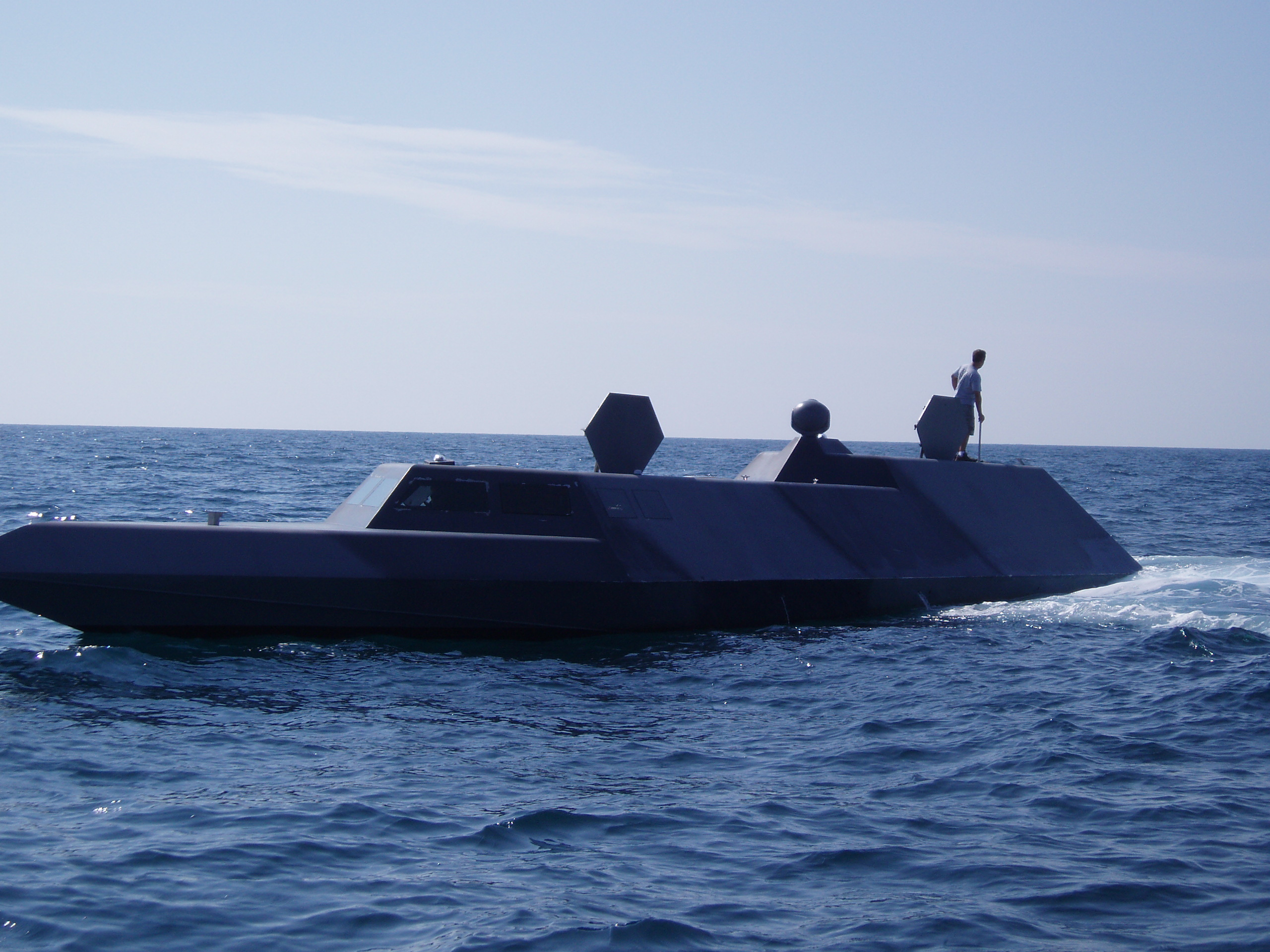
The confident man on the top looks as though he is operating the back hatch!
It did in fact look like a stealth bomber without wings. This boat wasn’t very tall. It looked as though it was designed to go through the waves not over them. Being it was unusually calm on this day; those present to see were sure that accomplishing maximum speed was going to take place. Of course, speculation was all anyone had to go by, but if you took into consideration the design of this boat, speed was never going to be an issue with any sea conditions.
The “stealth bomber without wings” boat called for the Coast Guard Station Tybee to have a vessel meet them at the mouth of the Savannah Shipping Channel. I wasn’t there for that viewing either. However, my phone rang off the hook with boaters pretty much describing a vessel that I had already heard about 40 miles earlier.
According to sources the vessel could cruise at around 55 knots. It was used for special covert operations. In this case “saving a fisherman’s life!”
I got the chance to interview the victim once he came home from the hospital along with the fisherman that rode in the vessel with him. Of course, my first question was “what did it look like inside?” The victim wished that he could remember, and the rider couldn’t because he was too busy experiencing seasickness beyond his control. However, he did say, “When the boat slowed down the helmsman grabbed a box with what looked like joy sticks and attached it to the outside top of the vessel. He them operated it from topside.”
The bottom line to this story is thank goodness the navy seals were there to assist. And we certainly do appreciate it! A big thanks goes out to them for coming to our aid!

retrieved from web site
I did a little checking, and this is the information this I came up with:
The Combatant Craft Heavy (CCH) SEALION is a surface vessel employed by the U.S Naval Special Warfare Special Boat Teams!
Their primary role of these teams is to insert and extract special operations forces, typically SEALS! They can carry out a range of maritime special operations such as counterterrorism, unconventional warfare, foreign internal defense, direct action, special/hydrographic reconnaissance.
This is one of the two prototypes’ designs SEALION-I AND SEALION-II. So therefore, Captain Ken as well as his crew got to see SEALION-I. Now how cool is this?
As far as equipment it had the latest and the greatest from stabilized infrared, day color, and low light camera, laser range find and laser pointer. And of course, all the stuff we charter captain are familiar with such as GPS, UHF, VHF, and then also the electronic stuff that we can only dream about.
Before I end this story, I must write a little about this boat’s engine room! According to information that I gathered this boat had two twin-water jet propulsion 10V2000 M93 CR diesel engines. As far as horsepower delivered, you aren’t going to believe this one, each engine was 1500 HP. Now, doing the proper addition that would make 3000 horsepower.
Now I would like to say, “If the stealth bomber without wings had them it could have broken the sound barrier for sure!”
Thanks for reading!
Captain Judy Out!

